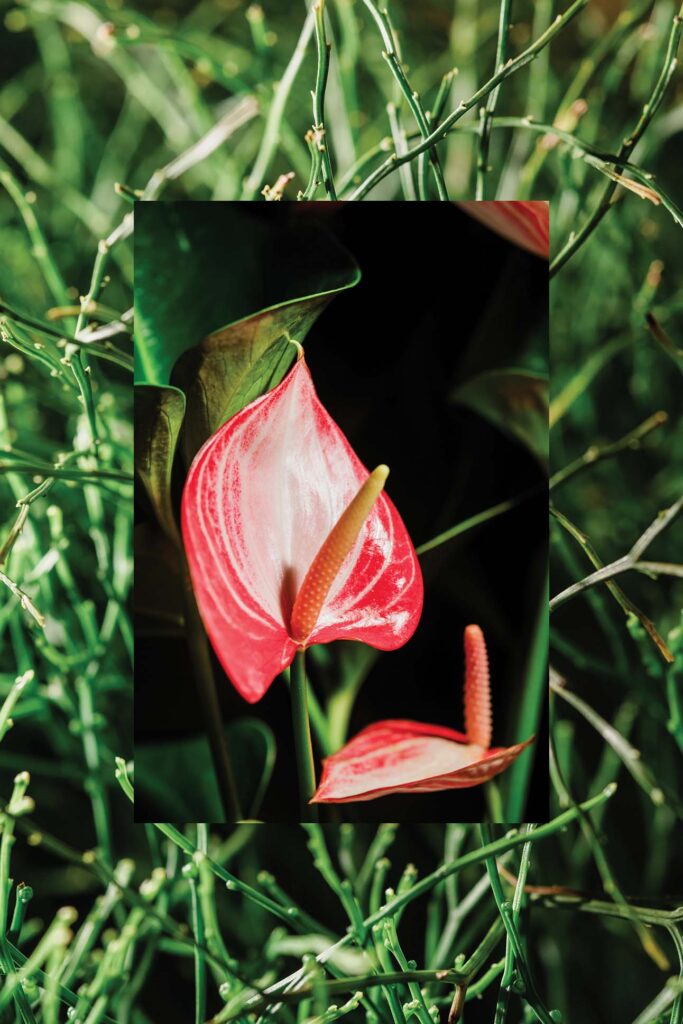Text by Natalie Schack
Images by John Hook
It’s June 2023, and the Honolulu Museum of Art has come alive with a vibrant array of blooms for the Garden Club of Honolulu’s triennial flower show. And to mark its return after an unexpected five-year hiatus—a byproduct of the COVID-19 pandemic—the year’s dazzling displays have been propagated, pruned, and arranged around a surprising theme: the ocean.
Outside along the airy corridors, succulent gardens burst from intricate seashell planters. Topiaries hang in the shape of dolphins. Step inside the galleries and you’ll find bits of protea, banana leaves, fishtail palms, and kukui nuts rolled into botanical nigiri and temaki sushi, along with foliage of every color fashioned into arrangements inspired by Hokusai’s infamous woodblock print The Great Wave off Kanagawa.

“Everyone wonders, ‘What does the ocean have to do with flowers and plants?’” says flower show co-chair Janice Fergus. “Because we’re on an island, everything came over the ocean—on birds, the wind, as seeds for plants.” Case in point: Mounted front and center on the museum’s main stage is one of the show’s pièces de résistance—a traditional sailing canoe nestled among a lush assemblage of staple crops brought to Hawai‘i by its first Polynesian settlers, including mai‘a (banana), kalo (taro), and niu (coconut).

With countless other displays and works of floral art lining the museum’s courtyards, colonnades, and galleries, the show is a monumental undertaking, and one of only nine of this magnitude organized by members of the Garden Club of America, a nonprofit organization comprised of 200 regional clubs and some 18,000 members around the country. It’s a particularly impressive feat when you consider that the Garden Club of Honolulu runs the event solo. (Other clubs on the U.S. mainland have the ability—that is, the proximity—to partner with neighboring clubs for events.)
The Garden Club of Honolulu has been orchestrating this visual spectacle at the museum since 1931. According to president Kitty Wo, it was the success of that inaugural show, and the impression it left on national judges, that made the club an official member of the larger Garden Club of America organization. Yet it isn’t the prizes, recognition, or even the beauty of the botanical creations themselves so much as the camaraderie among garden club members that has kept the show going strong for nearly a century.


“After the plants go back home, and the flowers die, and the photographs get filed, what you have left is relationships and the friendships you’ve made during this process,” says flower show co-chair Phyllis Lee. “I believe [the show] strengthens our club in a way that no other project can. We have common interests to start with, but when you work on something like this, it just brings you closer.”

The flower show is the group’s most high-profile endeavor, but as one of the national organization’s largest and most active clubs, it’s far from the Garden Club of Honolulu’s only initiative in plant education, conservation, horticulture, and botanical artistry. Other programs include monthly flower-arranging classes for inmates at the state’s only women’s prison, fundraising efforts for projects at local community gardens, and public classes on flower arranging, basket weaving, and plant education at Lyon Arboretum in Mānoa Valley. Members also tend to an area of Foster Botanical Garden that’s been in their stewardship for more than a decade. “All of these things help us prepare for the next show, in a way,” Fergus says. “It’s a learning process that never ends. And I think all of us are always curious, always wanting to learn something new.”








